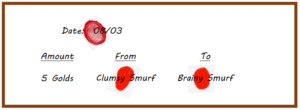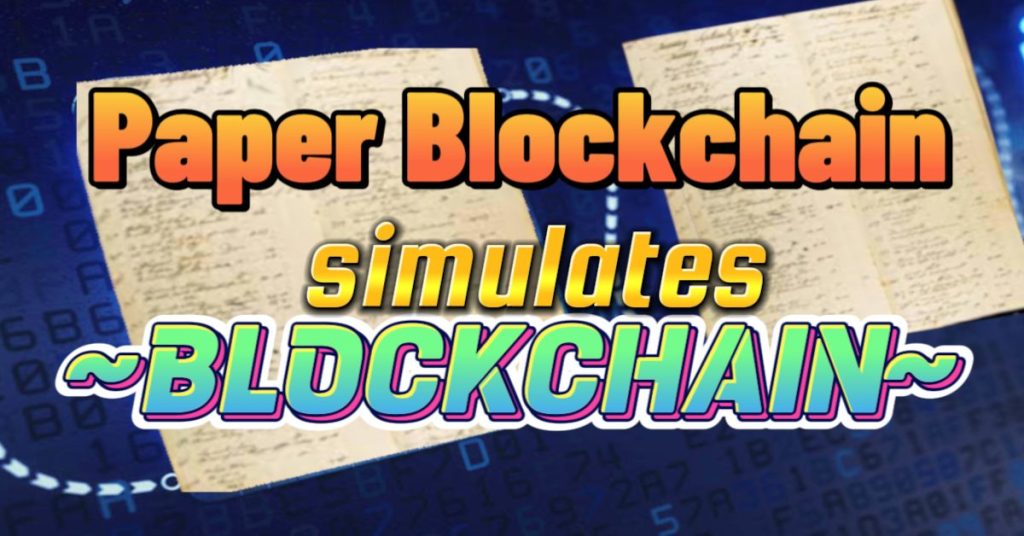Page Contents :
Definition Of Blockchain
Blockchain is essentially a database that chains blocks together in chronological order and uses an immutable cryptographic signature to ensure that the data is not tampered with or forged in the distributed ledger.
How Does The Paper Blockchain Work?
Everyone will find it is very difficult to understand how does the blockchain work and the way it generated? But we can simulate it in the real world to study and understand what a blockchain is.
Continue with our previous example of the smurf village, let imagine this small smurf village as a “little blockchain”.
In the beginning, Papa Smurf used to record every transaction of the smurfs on a daily basis. For instance, Baby Smurfette paid Hefty Smurf 2 golds for a bunch of 5 red roses, and Clumsy Smurf exchange two eggs for 1 bottle of milk with Brainy Smurf.
Because everyone believes in Papa Smurf, nobody will check or dispute the accuracy of this ledger. Gradually, the villagers discovered that Papa Smurf’s ledger had several mistakes. After a few discussion, everyone decided to take turns recording the ledger. However, some smurfs became sluggish over time and stopped recording throughout their turn.
So everyone come out with another solution, which was to set up a bulletin board inside the village and staple the ledger page by page on the bulletin board in chronological order. The bulletin board is supervised by the administrator 24 hours every day to make sure nobody will tamper with the ledger pages.

When the villagers make transactions, they put the “unconfirmed” transaction items on the bulletin board, and the person (accountant) who records the ledger must confirm and verify the transaction and seal together with his own fingerprint, then staple the “valid” transaction ledger on the bulletin board just after the previous ledger page. Those that complete the transaction verification work can get some reward for its work.
Just like the paper ledger and digital ledger we mentioned before. That’s it. That’s a basic paper blockchain:
How Does The Distributed Blockchain Work?
We further extend the above ledger recording method to other villages, link all of the villages’ bulletin boards together, and share all ledger transactions with one another. Therefore, the accountants in the village will compete with each other to be the first to complete the verification work and acquire rewards.
When villagers make transactions, they will turn in the transaction items to the administrator of the bulletin board. The administrator will assign the “unconfirmed” transaction item a number, such as no.1101, and publish it on his bulletin board as well as broadcast to all other bulletin boards.
At the point when the accountants of each village saw the “unconfirmed” transaction item no.1101 and recorded it on a piece of ledger paper, then they will confirm it with the villager who issued the no.1101 transaction item in the shortest possible time. After successfully confirmed the transaction and obtained the signatures of both parties, the accountant will need to seal his fingerprints on the ledger paper.
The accountant who completes the work will submit his ledger paper to the administrator of the bulletin board as soon as possible. The administrator will publish this verified “valid” ledger paper on his bulletin board, at the same time this ledger record will be replicated and added to the bulletin boards of other villages. Other accountants must then abandon the no.1101 transaction item and continue for another new “unconfirmed” transaction item, such as the no.1127 transaction.
To put it another way, each village is a node. The winning accountant adds his ledger transaction to the node’s block, and the ledger transaction is automatically shared and synchronized across other distributed blocks, forming a complete blockchain distributed ledger.
As stated in previous articles, the Internet has draw out the blockchain. We also mentioned the invention of Ethereum and the introduction of smart contracts, as well as Decentralized Applications, lastly in this article we incorporate how blockchain works and how could it be generated. At this point, we have a firm grasp on the fundamentals of blockchain technology. In the coming sessions, we’ll delve further into some of blockchain’s foundational technologies.





Very good post. I absolutely appreciate this website. Stick with it!